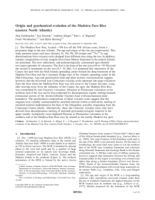Origin and geochemical evolution of the Madeira-Tore Rise

The Madeira-Tore Rise, located 700 km off the NW African coast, forms a prominent ridge in the east Atlantic. The age and origin of the rise are controversial. This study presents major and trace element, Sr, Nd, Pb, Hf isotope and 40Ar/39Ar age determinations from volcanic rocks dredged from different sites along the rise.
In addition, isotopic compositions of rock samples from Great Meteor Seamount in the central Atlantic are presented. The new radiometric and paleontologically constrained ages identify two major episodes of volcanism: The first is the base of the rise (circa 80 to >95 Ma) and the second is seamounts on the rise (0.5–16 Ma). It is proposed that interaction of the Canary hot spot with the Mid-Atlantic spreading center formed the deep basement of the Madeira-Tore Rise and the J-Anomaly Ridge west of the Atlantic spreading center in the Mid-Cretaceous.
Age and geochemical data and plate tectonic reconstructions suggest, however, that the recovered Late Cretaceous volcanic rocks represent late stage volcanism from the time when the Madeira-Tore Rise was still close to the Canary hot spot. Long after moving away from the influence of the Canary hot spot, the Madeira-Tore Rise was overprinted by late Cenozoic volcanism. Miocene to Pleistocene volcanism at the northern end of the rise can be best explained by decompression mantle melting beneath extensional sectors of the Azores-Gibraltar Fracture Zone (African-Eurasian plate boundary).
The geochemical compositions of these volcanic rocks suggest that the magmas were variably contaminated by enriched material within or derived by melting of enriched material underplated at the base of the lithosphere, possibly originating from the Cretaceous Canary plume. Alternatively, these late Cenozoic volcanic rocks may have derived from decompression melting of enriched pyroxenitic/eclogitic material in the upper mantle. Isotopically more depleted Pliocene to Pleistocene volcanism at the southern end of the Madeira-Tore Rise may be related to the nearby Madeira hot spot.







